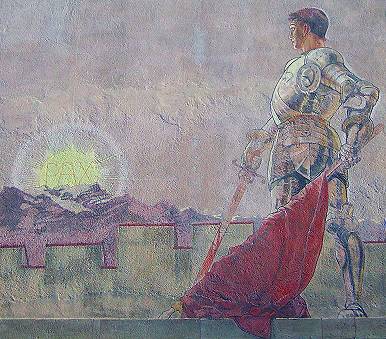SWITZERLAND
BOURBAKI PANORAMA
|
ALL ABOUT SWITZERLAND |
|
LUCERNE / LUZERN BOURBAKI PANORAMA |
|||||
|
Swiss Cities Basel Bern Geneva Lausanne Lucerne · Hotels · History · Chapel Bridge · Spreuer Bridge · Musegg Wall · Downtown · Jesuit Church · Hof Church · Franciscan Church · Paulus Church · Bourbaki Panorama · Wooden Houses · Pius Church St. Gallen Winterthur Zurich Alpine Resorts Bernese Oberland Zermatt/Matterhorn Swiss Tour Chillon Castle Rhine Falls |
Lucerne's Bourbaki Panorama
During the 19th and at the beginning of the 20th century, before the invention of movies, huge panoramic paintings were a major visual attraction in many major cities around the globe. From 1880 there was even an established standard size: 114 meters circumference x 14 to 15 meters height [125 x 15 yards]. Lucerne's Bourbaki Panorama was one in a series of panoramas built according to this standard. The idea was that the paintings might have been exchanged between panoramas to attract new spectators not able to travel around the globe. History shows that this remained a rather theoretical possibility, however. While the original cylindrical façade is still visible at the top section of the building, the ground, first and second floors have been enlarged by a cubical steel and glass structure. Below ground level two small movie theaters were added, on the ground floor there are some shops and a restaurant and on the first and second level you'll find the city's public library. |
Designed and painted in 1881 by Geneva born artist Edouard Castres, with the assistance of a few other painters (among them Ferdinand Hodler), Lucerne's Bourbaki panorama shows an episode from the Franco-Prussian war of 1870-71: Defeated in several battles, the French army of General Bourbaki was driven towards the French-Swiss border in February 1871. So they tried what new international law had foreseen for some time: foreign troops may seek refuge on neutral ground provided they deposit their arms and are interned in camps until the war is over. In this first test-case, Switzerland's authorities reacted promptly and the Bourbaki troops were allowed to cross the border at Les Verrières near Neuchâtel. The French troops remained in Switzerland until a formal cease-fire allowed for their return.
The painting shows an endless trek of soldiers in deplorable condition crossing the border. 21 life-sized dolls in historical uniforms, a real railway box car and scattered historical army equipment on a faux-terrain in front of the painting add to the illusion taking the spectators right into the scenery. The faux-terrain was rebuilt from scratch, enlarged and adapted to a more modern style when the whole building was renovated and modified in 1999/2000.

Detail of Lucerne's Bourbaki panorama painting by Edouard Castres
From a purely technical point of view, the Bourbaki Panorama is just another example of the late 19th century's panoramas. Edouard Castres' painting is unique, however, in the message it conveys: While other panoramas show off the glory of their victorious armies at the climax of nationalism throughout Europe (and the Americas), Castres' work points right at the ugly reality of war and advocates peace and humanitarian efforts.
The event itself was a key test both for the young Red Cross movement as well as for Switzerland's humanitarian role as a neutral country in a belligerent European environment. Castres' painting is therefore a first class historical testimonial. Needless to say that times have changed dramatically in the last 125 years: Europe has definitely found its way to peaceful coexistence and even close cooperation while new weapons and dimensions of warfare call for a new approach in humanitarian efforts.
Edouard Castres, Swiss painter (1838 - 1902), studied arts in Geneva, his teacher was Barthélémy Menn. In 1868 Castres moved to Paris. His paintings were shown off in Geneva and at the Paris Salon. When the Franco-Prussian war broke out in 1870, Castres volunteered as a Red Cross helper. At the time the Red Cross idea was still new. While the Geneva Conventions had been accepted and signed by all major European nations, their armies had only just begun to establish their medical service to take care of wounded soldiers. So the situation was quite different to modern times and volunteer helpers were most welcome. After the war, Castres tried to express his experience in a series of sketches, drawings and paintings.
The painting originally conformed to the standard size of 114 x 14 meters, but in 1926 the ground floor of the building was separated to allow for a commercial use. Two meters of the painting were removed from the top and 1949 another two meters fell victim to an enlargement of the ground floor. So the present-day panorama is only some ten meters high.
Bourbaki Panorama Lucerne
Löwenplatz 11
GPS coordinates: latitude=47.056674 longitude=8.311136
Take bus 1 to Löwenplatz from the main train station
map by www.google.com
Opening hours: daily, 9 am to 6 pm
 |
Information |
 Lucerne: Former Museum of Peace and War closed after World War I the building is now a public school this painting with the word PAX [peace] in the rising sun can still be seen on its north façade map by www.google.com |
 Basel: Strassburger Denkmal This monument reminds of civilians from the French city of Strasbourg who found shelter in the northwestern Swiss city of Basel during the 1870/71 German-French war. Located on the place in front of the Swiss Railway Station Basel. |

Short quotations allowed but with precise declaration of origin (Link).
Reproduction of substantial parts and pictures in printed or electronic form
only with explicit written consent by the editor.
| Disclaimer | Privacy Policy | www.all-about-switzerland.info © 2005-2010 All Rights Reserved | Editor | ||